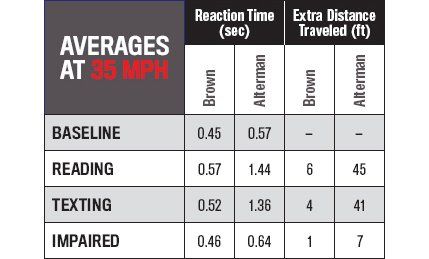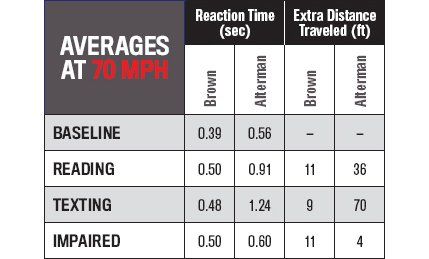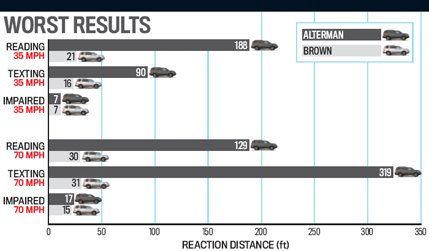Reading or Writing on a Phone Is Especially Dangerous While Driving Because
If you use a cell telephone, chances are you're aware of "text messaging"—brief messages limited to 160 characters that tin be sent or received on all modern mobile phones. Texting, besides known as SMS (for short message service), is on the ascension, up from 9.8 billion messages a calendar month in December '05 to 110.four billion in December '08. Undoubtedly, more a few of those messages are beingness sent by people driving cars. Is texting while driving a dangerous idea? We decided to bear a test.
Previous academic studies—much more scientific than ours—conducted in vehicle simulators take shown that texting while driving impairs the driver's abilities. But as far as nosotros know, no study has been conducted in a existent vehicle that is being driven. Also, we decided to compare the results of texting to the effects of drunkard driving, on the same day and under the exact aforementioned conditions. Not surprisingly, Car and Driver doesn't receive a lot of enquiry grants.
To keep things unproblematic, we would focus solely on the commuter'southward reaction times to a calorie-free mounted on the windshield at eye level, meant to simulate a pb car'southward brake lights. Wary of the potential damage to human and auto, all of the driving would exist done in a straight line. We rented the taxiway of the Oscoda-Wurtsmith Airport in Oscoda, Michigan, next to an 11,800-foot runway that used to be home to a squadron of B-52 bombers. Given the prevalence of the BlackBerry, the iPhone, and other text-friendly mobile phones, the test subjects would take devices with total "qwerty" keypads and would be using text-messaging phones familiar to them. Spider web intern Jordan Brown, 22, armed with an iPhone, would represent the younger oversupply. The older demographic would be covered by caput honcho Eddie Alterman, 37 (or 259 in domestic dog years), using a Samsung Allonym. (Alterman also uses a BlackBerry for east-post. We didn't utilize it in the test.)
Our long-term Honda Airplane pilot served as the examination vehicle. When the carmine light on the windshield lit upwardly, the commuter was to hit the brakes. The writer, riding shotgun, would use a hand-held switch to trigger the carmine light and monitor the driver's results. A Racelogic VBOX III data logger combined and recorded the test data from three areas: vehicle speed via the VBOX's GPS antenna; brake-pedal position and steering angle via the Pilot's OBD II port; and the red calorie-free's on/off condition through an analog input. Each trial would take the driver respond 5 times to the low-cal, and the slowest reaction time (the amount of time between the activation of the light and the driver striking the brakes) was dropped.
Outset, we tested both drivers' reaction times at 35 mph and 70 mph to get baseline readings. Then we repeated the driving process while they read a text message aloud (a series of Caddyshack quotes). This was followed by a trial with the drivers typing the same message they had only received. Both of our lab rats were instructed to use their phones exactly as they would on a public route, which, if Hashemite kingdom of jordan's mom or Eddie's wife are reading this, they never do.
Our test subjects then got out of the vehicle and concentrated on getting slightly intoxicated. They wanted something that would work quickly: screwdrivers (vodka and orange juice). Between the ii of them, they knocked back all but three ounces of a fifth of Smirnoff. Soon they were laughing at all our jokes, asking for cigarettes, and telling us most some previous time they got drunkard that was totally awesome. We had them blow into a Lifeloc FC10 breath-alcohol analyzer until they reached the legal driving limit of 0.08 percent claret-alcohol content. We then put them behind the bicycle and ran the light-and-brake examination without whatsoever texting lark.
The Results
The results, though non surprising, were eye-opening. Intern Dark-brown's baseline reaction time at 35 mph of 0.45 2nd worsened to 0.57 while reading a text, improved to 0.52 while writing a text, and returned most to the baseline while dumb by alcohol, at 0.46. At lxx mph, his baseline reaction was 0.39 2d, while the reading (0.50), texting (0.48), and drinking (0.50) numbers were similar. But the averages don't tell the whole story. Looking at Jordan'due south slowest reaction time at 35 mph, he traveled an extra 21 anxiety (more than a car length) earlier hitting the brakes while reading and went 16 feet longer while texting. At 70 mph, a vehicle travels 103 anxiety every second, and Dark-brown's worst reaction time while reading at that speed put him almost 30 feet (31 while typing) further down the road versus fifteen anxiety while boozer.
Alterman fared much, much worse. While reading a text and driving at 35 mph, his average baseline reaction time of 0.57 second nigh tripled, to 1.44 seconds. While texting, his response fourth dimension was 1.36 seconds. These figures correspond to an extra 45 and 41 feet, respectively, before hitting the brakes. His reaction time after drinking averaged 0.64 second and, by comparison, added only 7 feet. The results at 70 mph were similar: Alterman's response time while reading a text was 0.35 second longer than his base performance of 0.56 second, and writing a text added 0.68 second to his reaction fourth dimension. Merely his intoxicated number increased but 0.04 second over the base score, to a full of 0.60 second.
As with the younger driver, Alterman's slowest reaction times were a grim scenario. He went more than four seconds before looking up while reading a text message at 35 mph and over three and a half seconds while texting at 70 mph. Fifty-fifty in the all-time of his bad reaction times while reading or texting, Alterman traveled an actress 90 feet past his baseline functioning; in the worst case, he went 319 feet farther down the route. Moreover, his ii-hands-on-the-phone technique resulted in some serious lane drifting.
The prognosis doesn't improve when you await at the limitations of our examination. We were using a directly road without any traffic, route signals, or pedestrians, and we were just looking at reaction times. Fifty-fifty though our young commuter fared amend than the balding Alterman, Brown's method of belongings the telephone up above the dashboard and typing with one mitt would make information technology difficult to practise annihilation except hitting the brakes. And if annihilation in the periphery required a response, well, both drivers would probably be screwed.
Also, don't have the intoxicated results to be adequate only because they're an improvement over the texting numbers. They only look improve because the texting results are so horrendously bad. The buzzed Jordan had to be told twice which lane to drive in, and in the existent world, that fault could mean a head-on crash. And we remind again that nosotros only measured response to a light—the reduction in motor skills and cognitive power associated with impaired driving weren't really exposed here.
Both socially and legally, drunk driving is completely unacceptable. Texting, on the other hand, is still in its formative period with respect to laws and stance. A few jurisdictions have passed ordinances against texting while driving. Simply even if sweeping legislation were passed to outlaw any typing behind the wheel, it would nevertheless be hard to enforce the law.
In our test, neither field of study had any idea that using his telephone would slow downwards his reaction time so much. Like most folks, they think they're pretty good drivers. Our results prove otherwise, at both city and highway speeds. The key element to driving safely is keeping your eyes and your mind on the road. Text messaging distracts whatever driver from that primary task. So the next fourth dimension you lot're tempted to text, tweet, e-mail, or otherwise type while driving, either ignore the urge or pull over. We don't want you rear-ending us.
Read Phil LeBeau'south Coverage on CNBC: Texting and Driving Worse Than Drinking and Driving
This content is created and maintained past a 3rd party, and imported onto this page to help users provide their email addresses. You may be able to find more than information almost this and like content at pianoforte.io
Source: https://www.caranddriver.com/features/a16580948/texting-while-driving-how-dangerous-is-it/



0 Response to "Reading or Writing on a Phone Is Especially Dangerous While Driving Because"
Post a Comment